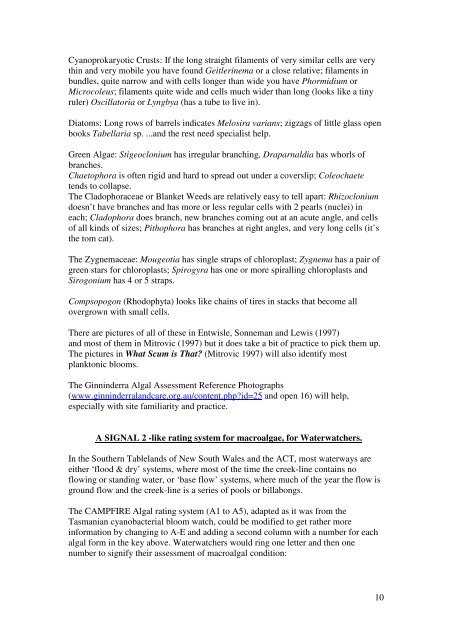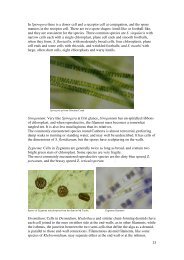Filamentous Freshwater Algae of the ACT, a preliminary list
Filamentous Freshwater Algae of the ACT, a preliminary list
Filamentous Freshwater Algae of the ACT, a preliminary list
Create successful ePaper yourself
Turn your PDF publications into a flip-book with our unique Google optimized e-Paper software.
Cyanoprokaryotic Crusts: If <strong>the</strong> long straight filaments <strong>of</strong> very similar cells are very<br />
thin and very mobile you have found Geitlerinema or a close relative; filaments in<br />
bundles, quite narrow and with cells longer than wide you have Phormidium or<br />
Microcoleus; filaments quite wide and cells much wider than long (looks like a tiny<br />
ruler) Oscillatoria or Lyngbya (has a tube to live in).<br />
Diatoms: Long rows <strong>of</strong> barrels indicates Melosira varians; zigzags <strong>of</strong> little glass open<br />
books Tabellaria sp. ...and <strong>the</strong> rest need specia<strong>list</strong> help.<br />
Green <strong>Algae</strong>: Stigeoclonium has irregular branching, Draparnaldia has whorls <strong>of</strong><br />
branches.<br />
Chaetophora is <strong>of</strong>ten rigid and hard to spread out under a coverslip; Coleochaete<br />
tends to collapse.<br />
The Cladophoraceae or Blanket Weeds are relatively easy to tell apart: Rhizoclonium<br />
doesn’t have branches and has more or less regular cells with 2 pearls (nuclei) in<br />
each; Cladophora does branch, new branches coming out at an acute angle, and cells<br />
<strong>of</strong> all kinds <strong>of</strong> sizes; Pithophora has branches at right angles, and very long cells (it’s<br />
<strong>the</strong> tom cat).<br />
The Zygnemaceae: Mougeotia has single straps <strong>of</strong> chloroplast; Zygnema has a pair <strong>of</strong><br />
green stars for chloroplasts; Spirogyra has one or more spiralling chloroplasts and<br />
Sirogonium has 4 or 5 straps.<br />
Compsopogon (Rhodophyta) looks like chains <strong>of</strong> tires in stacks that become all<br />
overgrown with small cells.<br />
There are pictures <strong>of</strong> all <strong>of</strong> <strong>the</strong>se in Entwisle, Sonneman and Lewis (1997)<br />
and most <strong>of</strong> <strong>the</strong>m in Mitrovic (1997) but it does take a bit <strong>of</strong> practice to pick <strong>the</strong>m up.<br />
The pictures in What Scum is That? (Mitrovic 1997) will also identify most<br />
planktonic blooms.<br />
The Ginninderra Algal Assessment Reference Photographs<br />
(www.ginninderralandcare.org.au/content.php?id=25 and open 16) will help,<br />
especially with site familiarity and practice.<br />
A SIGNAL 2 -like rating system for macroalgae, for Waterwatchers.<br />
In <strong>the</strong> Sou<strong>the</strong>rn Tablelands <strong>of</strong> New South Wales and <strong>the</strong> <strong>ACT</strong>, most waterways are<br />
ei<strong>the</strong>r ‘flood & dry’ systems, where most <strong>of</strong> <strong>the</strong> time <strong>the</strong> creek-line contains no<br />
flowing or standing water, or ‘base flow’ systems, where much <strong>of</strong> <strong>the</strong> year <strong>the</strong> flow is<br />
ground flow and <strong>the</strong> creek-line is a series <strong>of</strong> pools or billabongs.<br />
The CAMPFIRE Algal rating system (A1 to A5), adapted as it was from <strong>the</strong><br />
Tasmanian cyanobacterial bloom watch, could be modified to get ra<strong>the</strong>r more<br />
information by changing to A-E and adding a second column with a number for each<br />
algal form in <strong>the</strong> key above. Waterwatchers would ring one letter and <strong>the</strong>n one<br />
number to signify <strong>the</strong>ir assessment <strong>of</strong> macroalgal condition:<br />
10



